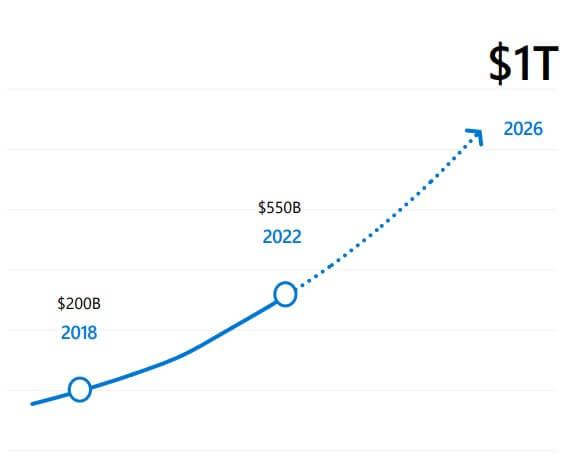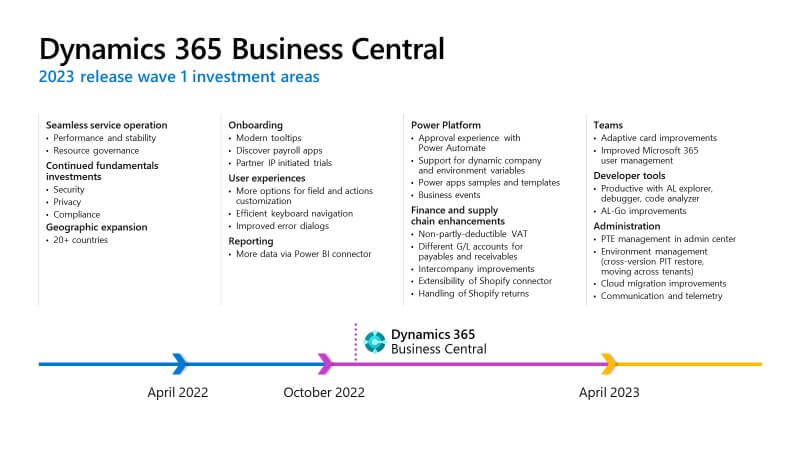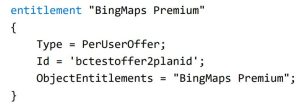The beautiful city of Hamburg hosted the 2022 edition of the Directions EMEA conference two weeks ago, the main world’s partner’s related conference about Dynamics 365 Business Central and its ecosystem.
As usual, many partners were at the conference to learn more about the present and future of the entire Microsoft Business Applications stack present and future, and many messages and inputs were launched during these three conference days.
We’re now exactly 20 years since Microsoft acquired Navision, and a lot is changed during this period. The ERP is evolving, and the world of ERP projects is changing. The demand for cloud solutions will continue to accelerate, and an IDC estimate says that 80% of sales interactions will happen through digital channels by 2025.
Dynamics 365 Business Central: What’s coming to 2023 release wave 1?
Dynamics 365 Business Central is now one of the fastest-growing products in the Microsoft Business App division. It’s now one of the most reliable SaaS-based ERP platforms and has the fastest-growing marketplace of applications made by partners. There are more apps in AppSource for Dynamics 365 Business Central than any other products at Microsoft.
These numbers and the Business Central’s growing adoption have the main result: Dynamics 365 Business Central is used as a model for SMB success across Microsoft.
The roadmap for the next wave was announced:
There important messages from this roadmap are the following:
- You will have better possibilities to manage the administration of a cloud environment with the support of cross-version restores and tenant moves. A new PTE management section in Admin Center will be added.
- You will have new developer tools, like AL explorer (stay tuned).
- As usual, you will have improvements in the Business Application area.
- Power Platform integrations will always be more pushed.
Also, if not stated in the roadmap, Microsoft invests much energy in making the online platform as reliable and performant as possible.
Dynamics 365 Business Central is designed for scale. It uses dynamic scaling for computing resources and databases and intelligent load balancing.
In terms of hardware resources:
- 84% of session minutes are served by machines running within the target capacity
- 96% of databases running within the target capacity
Microsoft always ensures that there are enough hardware resources for all SMB workloads.
The platform is also designed to handle many requests from the outside. The usage of APIs and integrations is growing (external applications, Power BI, Power Platform connectors, etc.). To give some numbers:
- From 15K to 5.2M API requests per day received
- 90% of API requests are served in under 250 ms
- 1% > 5 sec
Universal Code Initiative
The focus today is the cloud, and it’s the cloud that drives innovation. The Universal Code initiative (also emphasized during the conference) clearly stated that you must write SaaS-compliant code.
Business Central on-premise platform will only allow “Universal Code” for customizations in customer environments, and using non- “Universal Code” modules will require additional modules to be licensed. This will be enforced by the platform (i.e., technical enforcement). Any Business Central implementations created before October 3, 2022, as indicated by the implementation’s initial product line registration date for Business Central in the implementation’s license key, do NOT require the non-“Universal Code” module (or fee). This exemption includes Business Central implementations created before October 3, 2022, due to a prior transition from NAV/GP/SL.
AppSource Marketplace
Also, new essential changes will appear next year for ISVs and applications published on the AppSource marketplace. You will be able to publish an offer on AppSource, and when published, you will be able to choose whether you want to sell this offer through Microsoft (Microsoft will host transactions on your behalf).
Plans for the monetization features are the following:
- You can specify individual SKUs unlocking various levels of functionalities for your apps
- You can specify user levels (1 to 10 users à price A, 10 to 20 users à price B, etc.).
Future plans also permit you to define “private plans,” hidden in AppSource by default, and that can be made available only for specific AAD tenants.
The key to this new monetization feature is one: you need to define entitlements in your apps:
Please remember that being entitled to objects still requires permission to use their objects.
But despite that, what’s the main message that pops out from this edition of Directions EMEA? That the ERP projects now should be managed differently. An ERP project now should not involve only the ERP (Business Central) but also Azure and Power Platform.
Microsoft Power Platform
Directions EMEA puts a big emphasis (maybe too much, someone can say) on the Power Platform for the first time in its history. Microsoft Power Platform is a tremendous emerging technology with an expected 82% YOY growth.
Dynamics 365 Business Central is only a piece of an extensive ecosystem of apps that spans Microsoft 365, Dynamics 365, and Power Platform. Here is the diagram I’ve used in my session to give you an overview:
Here there are two important building blocks (backbones) for a modern ERP project:
- Microsoft Dataverse
- Azure
Building an app typically involves data from more than one source. Although this can sometimes be done at the application level, there are cases where integrating this data into a common store allows for an easier app-building experience and a single set of logic to maintain and operate over the data. Dataverse will enable data to be integrated from multiple sources into a single store, which can then be used in Power Apps, Power Automate, Power BI, Azure services, etc., along with data already available from the Dynamics 365 applications.
This concept was a core concept that I personally emphasized in a session where we talked about a real-world modern ERP project that involved Business Central, Power Platform, Dataverse, and different Azure Services.
Please remember that:
- Using more of the Microsoft stack can result in a reliable architecture
- Using the right tool for the job can bring additional benefits, such as scalability and enhanced features
- Licensing and Azure consumption isn’t always cost prohibitive
- Breaking the architecture into small chunks doesn’t make it more complex
- Without the wider Microsoft toolset, it is more difficult to build out a purposeful solution
- This type of model can be applied to many more real-world solution
Start thinking about that…
Microsoft Teams
Another important announcement is the ability to embed Dynamics 365 Business Central pages into Teams as tabs, with the possibility of having:
- Full access to Business Central data (read/write permissions): a Business Central license is required
- Full read-only access to any Business Central data: this can be done FOR FREE for any users in your organization.
In Teams, tabs appear at the top of channels and chats, giving participants quick access to pertinent information:
You can now create a user with only an M365 license assigned, add it to your Business Central environment (User page) and add a role. This user (that doesn’t have a Business Central license assigned) will be able to read Business Central data (accordingly to the role assigned). It will not be able to perform data modifications.
Please remember that embedding data in Teams tabs is only available for Business Central online and requires the Business Central app for Teams version 1.0.8 or later.
A developer can also add Business Central pages in a Teams tab programmatically by using Microsoft REST Graph APIs.
To add a Business Central tab to a channel or chat, you send a POST request to either the channel tab or chat tab endpoint:
POST https://graph.microsoft.com/v1.0/teams/{teamId}/channels/{channelId}/tabs
{
"displayName": "<tab name>",
"[email protected]": "https://graph.microsoft.com/v1.0/appCatalogs/teamsApps/84c2de91-84e8-4bbf-b15d-9ef33245ad29",
"configuration": {
"entityId": "<unique id>",
"contentUrl": "https://businesscentral.dynamics.com/teams?<company and page ID>",
"websiteUrl": "https://businesscentral.dynamics.com/?<company and page ID>"
}
}
The user identity that runs the code must have access to the Business Central app for Teams for the POST request to succeed.
As you can see, there are now lots of opportunities and technologies for improving your ERP solutions. The Business Central platform is always evolving (expect more exciting features in the next waves), but now it’s time to change your mind about handling ERP projects. A modern SaaS ERP project cannot rely on AL for all tasks. Outside the door, there’s a big universe (Azure serverless platform and Dataverse, to give some names) that can help you architect more efficient solutions for your customers.




